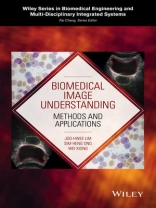A comprehensive guide to understanding and interpreting
digital images in medical and functional applications
Biomedical Image Understanding focuses on image
understanding and semantic interpretation, with clear introductions
to related concepts, in-depth theoretical analysis, and detailed
descriptions of important biomedical applications. It covers image
processing, image filtering, enhancement, de-noising, restoration,
and reconstruction; image segmentation and feature extraction;
registration; clustering, pattern classification, and data
fusion.
With contributions from experts in China, France, Italy, Japan,
Singapore, the United Kingdom, and the United States, Biomedical
Image Understanding:
* Addresses motion tracking and knowledge-based systems, two
areas which are not covered extensively elsewhere in a biomedical
context
* Describes important clinical applications, such as virtual
colonoscopy, ocular disease diagnosis, and liver tumor
detection
* Contains twelve self-contained chapters, each with an
introduction to basic concepts, principles, and methods, and a case
study or application
With over 150 diagrams and illustrations, this bookis an
essential resource for the reader interested in rapidly advancing
research and applications in biomedical image understanding.
A propos de l’auteur
Joo-Hwee Lim is the Head of the Visual Computing
Department at the Institute for Infocomm Research (I²R),
A*STAR, Singapore, and an Adjunct Associate Professor at the School
of Computer Engineering, Nanyang Technological University,
Singapore. He is the co-Director of IPAL (Image & Pervasive
Access Laboratory), a French-Singapore Joint Lab. He established
the medical image analysis group at I²R in 2006,
collaborating with clinicians closely, resulting in strong
competency in ocular imaging, brain image analysis, cell image
understanding etc at the institute. He has published over 200
journal and conference papers and owns 17 patents in the areas of
computer vision, cognitive vision, pattern recognition, and medical
image analysis.
Sim-Heng Ong is an Associate Professor in the Departments of
Electrical Engineering and Bioengineering at the National
University of Singapore. He received his Ph D from the University of
Sydney, Australia. His major research areas are computer vision and
medical image analysis and visualization. He has worked extensively
with clinicians in developing algorithms for a variety of medical
applications, and has publications in many highly respected
journals and conferences.
Wei Xiong is a Research Scientist at the Institute for
Infocomm Research (I²R), A*STAR, Singapore. He obtained
his Ph D degree from the National University of Singapore. His
research interest is in computer vision, image processing, pattern
classification and acoustic imaging. Dr. Xiong has published over
60 technical papers.












